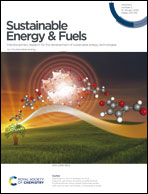Carbazole-based D–A type hole transport materials to enhance the performance of perovskite solar cells†
Abstract
D–A type carbazole derivatives (KZ, KZIC and KZRD) are reported as hole transport materials (HTMs) in conventional perovskite solar cells (PSCs). In KZ, carbazole is substituted by diphenylamine groups at the 3,6-position. In KZIC and KZRD, KZ functions as the donor group, with 3-(dicyanomethylene) indone and 3-ethyl rhodanine as the electron-withdrawing groups, respectively. The D–A type molecular structure offers strong electrostatic surface potential on the acceptor part, which could enhance the molecular interaction. The photophysical and electronic properties of the newly designed compounds were studied, and the effect of the molecular structure on the hole transport properties as well as device performances was investigated. The KZRD film exhibits a smoother surface morphology and higher hole mobility compared to KZ and KZIC, ensuring good interfacial contact and efficient hole transport ability. Moreover, the sulfur atom and carbonyl group in KZRD could more effectively passivate defects at the perovskite/HTM interface. Therefore, PSCs using KZRD as the HTM exhibited a high power conversion efficiency of 20.40%, outperforming that of KZ and KZIC-based PSCs.



 Please wait while we load your content...
Please wait while we load your content...